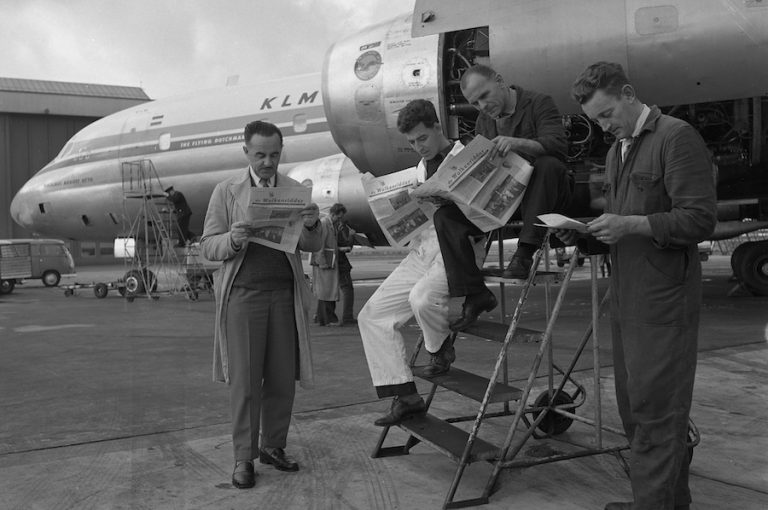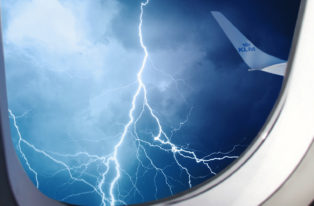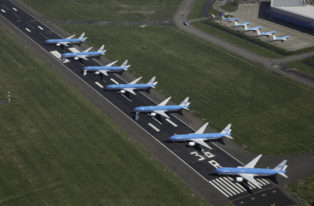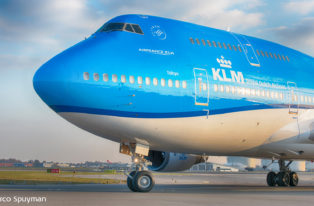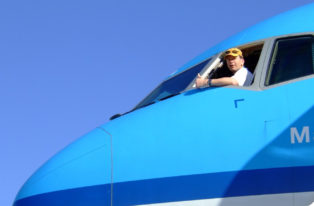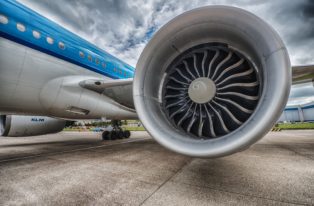The Wolkenridder: The Tie that Binds KLM Staff
Certainly if you have ever worked for a larger organisation, you’ll be familiar with the phenomenon of the personnel magazine. You might not wait for it with baited breath, but you receive it nevertheless. Maybe you devour each page. Since 1946, KLM has had its very own version with the now slightly corny name of Wolkenridder—and equally untranslatable into English as Cloud Knight. And yet… anyone who says Wolkenridder, says KLM. This blog offers a brief history of the dyed-in-the-wool KLM magazine.
Leisure publication
It would be wrong to assume that, throughout the first twenty-seven years of its existence, KLM did without a publication. Before the Second World War, there was a comparable magazine. It had a different name—perhaps an even more appropriate one: The Flying Dutchman. The first edition was released in January 1934 and comprised a few typed pages which were then stencilled and distributed. Not everyone received a copy. You had to subscribe, though for a nominal amount. KLM staff were welcome to make their own contributions, which resulted in a variety of subject matter and writing ability. In the foreword marking the occasion of KLM’s fifteenth anniversary in October of 1934, Albert Plesman referred to The Flying Dutchman as a “leisure publication,” but one that—by offering news and information about KLM—served to establish and strengthen the ties between KLM staff. And he was right to say so.
Slowly but surely, the magazine grew and matured. A few years later, it took on a proper layout—complete with photographs—all printed on glossy stock. However the copy continued to come from anyone who felt the calling to make a contribution. There was little in the way of editorial control. But, through the years, the content grew stronger. There was more news about the organisation and less idle chat and hobby talk. The outbreak of the Second World War stopped the magazine dead in its tracks.
A new start
When the war came to an end, publication resumed in the form of a new magazine: the Wolkenridder. The first edition appeared on Saturday 5 October 1946, just before KLM’s anniversary. It consisted of just four pages. It wasn’t much, but it was a start. A foreword by Plesman introduced the new magazine. Once again, he made a call for contributions because, without the help of the staff, there would be no staff magazine. People listened. A year later, the Wolkenridder announced that it would expand to sixteen pages. According to the editorial board, that would, “increase the publication’s appeal”. In return, subscribers had to pay one guilder per year. It took some time to achieve the promised sixteen pages. Only in August of 1948 did it fulfil its ambition. From the start, a new edition appeared every two weeks.
Active club life
The ideal staff magazine should offer a combination of information and entertainment. At least, that’s how I see it. We want to see our colleagues reflected in its pages and we want to know what’s happening in and around the organisation. The original editors and all who have worked on it during its nearly seventy-year history seem to have understood that well. The Wolkenridder has been a treasure trove of information about KLM’s ups and downs, the opportunities and threats, developments in aviation technology, the advent of new uniforms or aircraft types, the opening of a KLM hotel, new routes—the list goes on and on.
And let’s not forget the personnel clubs. KLM staff do not only gather at work, but outside work as well. KLM has done a great deal to create and support clubs, and that was easy to see in its pages featuring information about all the various clubs. Soccer, tennis, chess, stamp collecting, rambling, singing—there seemed to be a club for everything. As a result, the Wolkenridder has become a rich historical source for a company where no two days were ever the same.
Goodbye newspaper
But a good staff magazine has to travel with the times. Occasionally a reader survey identifies strengths and weaknesses and gives a picture of the readership’s needs and wishes. This would explain its changes in form and content. Late in the 1940s, the Wolkenridder became a newspaper. A combination of shorter and longer articles, photos, and a set of recurring columns turned the house paper into KLM’s all-seeing eye. Gradually, the slightly amateurish contributions began to disappear. In its place a professional editorial board took shape which took its task seriously. Only in 1991 did KLM let go of the newspaper format and the Wolkenridder took shape in magazine form, appearing every month. The Wolkenridder Actueel (Wolkenridder Daily in English) handled more immediate information in the form of a newsletter. The Wolkenridder became more a source of background information, but not without stories about colleagues, their work, their passions, interests—and all in combination with developments inside and outside the world of civil aviation.
A product of its time
Technology is always moving and changing. With the advent of the Internet and, ultimately, digital magazines, new needs began to arise. The Wolkenridder was no exception, though the paper version managed to hang on for a long time. This week, however, that came to an end. The final Wolkenridder in paper form has now been released and the editorial board is already hard at work on its digital successor. A staff magazine is very much a product of its time. A Wolkenridder from 1956 is now a curiosity. It’s almost quaint. Today, we demand more immediacy—more speed—and we can accommodate that, too. Digitisation is the answer. Who knows? Perhaps thirty years from now, paper magazines will be hot. But one thing is certain—and of this I am certain— by letting go of the old, we make room for the new. The Wolkenridder lives on.
